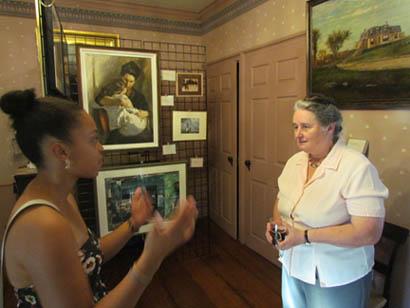July 4, 2012

At “Dorchester Artists: Past and Present,” Kyara Andrade, at left, a contemporary Dot artist, chatted with Karen MacNutt, daughter of deceased Dot artist Glenn Macnutt, whose “Mother and Child” is behind them. Photo by Andrea Kunst
As part of its second annual Dorchester Descendants festivities last weekend, the Dorchester Historical Society (DHS) threw open its doors for a double-barreled, century-spanning art display at the William Clapp House, the DHS headquarters at 195 Boston Street.
The three-day “Dorchester Artists: Past & Present” featured works by painters, photographers, sculptors, ceramicists and cartoonists who lived at some point in their lives in the neighborhood. Works by artists largely from the nineteenth century were selected by DHS President Earl Taylor and hung in the “second best parlor” while an unjuried show of contemporary pieces was coordinated by Andrea Kunst, Chair of the Board of the Dorchester Arts Collaborative (DAC), in the “best parlor.”
Taylor printed up an illustrated mini-catalogue full of fascinating facts about 23 bygone local visual artists. In addition to the well-known Impressionists F. Childe Hassam and Edmund Charles Tarbell, Taylor spotlighted eminent book illustrator Frank Merrill, represented by his images for Dumas’ “The Count of Monte Cristo” and for “The House on the Downs,” a 1925 mystery novel by popular Dot author, Gladys Edson Locke.
Many visitors indicated as their favorites in this section the breezy Dorchester street scenes by Canadian born Glenn Macnutt (1905-1987), an early pioneer in the use of acrylic and a practitioner of the motto “You have to learn to paint what you see.”
Kunst pulled together the display of 32 pieces by such present-day locals as Gary Gartley, Barbara Ward, Martha Kempe, Jennifer Johnson, Marcia Sewell, Howie Green, Kyara Andrade, Vincent Crotty, Bob Tobio, Elaine Croce-Happnie, David Stokle, Ina Nenortas, James Hobin and Joe Bagley.
Compared with the relative sameness of the landscapes, portraits and sketches of the earlier eras, the modern pieces evinced a much wider variety of themes, media and techniques ranging from Jim Hobin’s familiar color lithograph of “Sledding Down Savin Hill” to Howie Green’s pop impressionist rendering of the “Clapp Pear” statute in Edward Everett Square.
Joe Bagley, who just became the caretaker of the William Clapp House, impressed visitors with his amazingly intricate hand cut black paper art, some pieces being valued at $6000. Another crowd-pleaser was Ina Nenortas’ irregularly shaped quilt of photo transfer fabric images of 100 different Dorchester houses, one of the few pieces not for sale.
By all accounts the opening reception on Friday night was a tremendous success with a crowd of more than 70. According to Kunst the evening was “a wonderful bridging of the historic with the present. No one was tied to just one room or the other.”
Though more visitors streamed through this “pop-up” show on Saturday and Sunday, many expressed the wish that it could have been up for a longer period. There was talk of remounting the exhibit in some form for the 2012 October Dorchester Open Studios.
In any case, Taylor and Kunst both said their organizations would be happy to do something like this again next year.
Topics:


